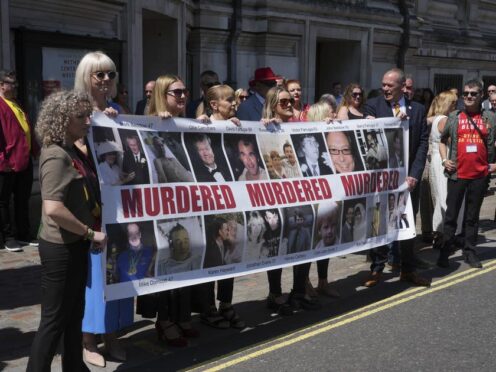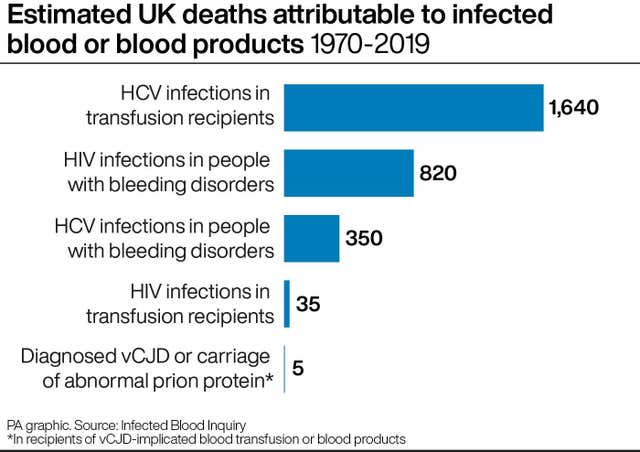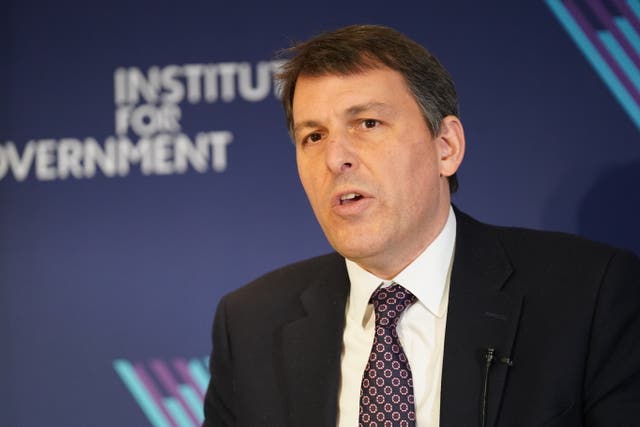
People who were infected with deadly viruses as a result of the contaminated blood scandal could receive more than £2 million in compensation, according to Government documents.
“Illustrative figures” have been published in the new Infected Blood Compensation Authority section of the Government website which show “the compensation award that an infected person living with a single infection or co-infection may expect to receive”.
The documents say that people living with an HIV infection as a result of the scandal could receive between £2.2 million and £2.6 million.
Payments for people living with hepatitis vary from £35,500 for an “acute” infection up to £1,557,000 for the most severe illnesses caused by the virus, according to the figures.
People infected with both viruses could be paid up to £2.7 million, the tables show.
More than 30,000 people were infected with deadly viruses between the 1970s and early 1990s as they received blood transfusions or blood products while receiving NHS care.
The 2,527-page report from the Infected Blood Inquiry, published on Monday, found the infected blood scandal “could largely have been avoided” and there was a “pervasive” cover-up to hide the truth.
Some 3,000 people have since died.
The illustrative figures were published as the Government set out more details of the compensation scheme, although they are not final numbers and should be treated with caution.

Cabinet Office minister John Glen said he recognised that “time is of the essence” as he confirmed that the first full compensation payments to victims will be made before the end of the year.
In the meantime, some victims will receive a £210,000 interim payment before the end of the summer, he said.
Mr Glen also announced that family members of those infected would also be eligible for compensation.
The illustrative figures also show how much family members may expect to receive by way of compensation. For example, the partner of someone infected with HIV who is still alive today could receive around £110,000, while a child could get £55,000, and siblings could receive £30,000.
Mr Glen also announced that Sir Robert Francis KC has been announced as the interim chairman of the shadow body set up ahead of the arm’s-length Infected Blood Compensation Authority
Flanked in the House of Commons by Chancellor Jeremy Hunt and Deputy Prime Minister Oliver Dowden, Mr Glen did not confirm the total cost of the compensation package for those affected by the scandal, though it is reported to be more than £10 billion.

He told MPs: “Those who have been infected or affected as a result of this scandal will receive compensation.
“When a person with an eligible infection has been accepted on to the scheme, their affected loved ones will be able to apply for compensation in their own right.
“That means partners, parents, siblings, children, friends and family who have acted as carers of those who are infected are all eligible to claim.
“Our expectation is that final payments will start before the end of the year.”
He confirmed that anyone already registered with one of the existing support schemes will automatically be considered eligible for compensation.
Mr Glen said there will be five categories under which compensation will be awarded – injury, social impact, autonomy, care and financial loss – and multiple awards will be provided where applicable.

The illustrative tables calculate the possible payouts based “across all categories of award”.
On existing support schemes, Mr Glen added: “Payments will continue to be made at the same level until 31 March 2025 and they will not be deducted from any compensation awards. From 1 April 2025, any support scheme payments received will be counted towards a beneficiary’s final compensation award.”
Sir Robert said: “I am humbled to be asked to chair the Infected Blood Compensation Authority on an interim basis.
“Having witnessed the depth of victims’ suffering as I compiled my report on the compensation framework, I know the urgency of providing them with the remedies they are entitled to as soon as is practicable.”
Jason Evans, director of the Factor 8 campaign group, called for more clarity on the scheme, adding: “Taken together, the Government’s announcement today creates fresh disparity. Some estates may have received £310,000 in total interim payments by the summer, while most may have received nothing.”
PRESS STATEMENT ON INFECTED BLOOD COMPENSATION RESPONSE
Responding to the statement to the House of Commons today on Infected Blood Compensation by the Paymaster General @JohnGlenUK
Jason Evans (Director of Factor 8) said: "We welcome the news today that Sir Robert Francis KC…
— Factor 8 (@Factor8Campaign) May 21, 2024
Rachel Halford, chief executive of the Hepatitis C Trust, said: “Interim payments of a further £210,000 will provide reassurance to many facing financial hardship because of years of ill-health, job loss or caring responsibilities linked to this scandal.
“While the indications of the announcement are promising, much more detail is urgently needed to clarify who will be able to access financial support and when, alongside clearer information on the future of existing blood support schemes.”
Richard Angell, chief executive at Terrence Higgins Trust, said: “There is a lot to welcome in today’s statement by the Government – the appointment of Sir Robert Francis KC, the additional interim payment and the desire to expedite final settlement payments.
“Whether the government’s proposals adequately compensate both those infected and affected is still to be seen. Much relies on effective consultation and involvement of the community.
“The priority now must be ensuring that everyone who is entitled to compensation gets it and gets it quick.”
Kate Burt, chief executive of the Haemophilia Society, said: “Today our community has received a huge amount of information from the government about potential compensation payments which we must now take time to consider.
“Although this has been far too slow to get under way, it is now encouraging that the process of recognising people’s loss through compensation appears to be gathering momentum.”
The Infected Blood Inquiry said harm done to those affected was “compounded” by the Government’s “sluggish pace” on compensation.
Inquiry chairman Sir Brian Langstaff made his final recommendations on compensation in April 2023, saying victims should not face any more delays for redress.
He said an arms-length compensation scheme should be established before the final report of his inquiry, but full details of the scheme were only confirmed by ministers the day after the inquiry concluded.
The Government has faced heavy criticism from campaigners for delays in introducing the scheme.

Enjoy the convenience of having The Sunday Post delivered as a digital ePaper straight to your smartphone, tablet or computer.
Subscribe for only £5.49 a month and enjoy all the benefits of the printed paper as a digital replica.
Subscribe